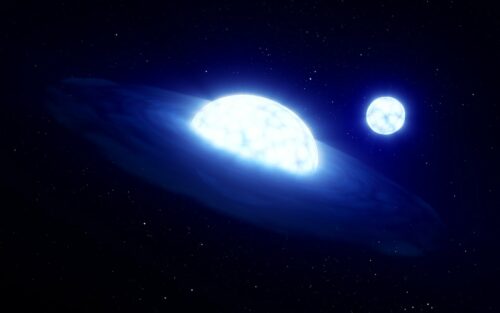Image Courtesy of European Southern Observatory/L. Calçada.
Where is Earth’s nearest black hole? Scientists thought they knew the answer—a celestial object called HR 6819, 1120 light years from the sun. However, a recent study in Astronomy & Astrophysics refuted this hypothesis with higher-resolution observations and mathematical models, yielding findings that are nevertheless just as exciting.
In 2020, Thomas Rivinius and colleagues at the European Southern Observatory (ESO) claimed that HR 6819 was a triple system with a black hole, a closely orbiting star, and another star orbiting farther from the center. According to this model, HR 6819 would include the closest black hole to Earth.
It was reasonable for the Rivinius team to come to this conclusion. Astronomers classify stars into O, B, A, F, G, K, or M classes, a sequence of decreasing mass and temperature. Stars in different classes yield different spectra of electromagnetic radiation, a characteristic widely used to study celestial objects. A binary system with two typical B stars wouldn’t produce the spectrum that was observed. “Looking at the motion of the [spectral emission] lines, they thought that there was an unseen companion in the system,” said Abigail Frost, a postdoctoral researcher at KU Leuven in Belgium and the first author of this newly published study.
Frost and colleagues, however, recalled another system, LB1, which was initially thought to contain a black hole but turned out to be a rare binary system with a stripped B star and a B emission star (Be star). One hypothesis for its formation starts with a binary system of two B stars. Stars expand over time, and the more massive a star is, the faster it expands. At some point, the larger star in the system, the primary star, gets so big that the secondary star strips away some of its mass. The primary star is left with only its core, a stripped B star, and the secondary star becomes a Be star. “[A Be star] spins so fast that at the equator, the centrifugal force due to rotation is equal to gravity, so the star flattens, creating a disc,” said Hugues Sana, an associate professor at KU Leuven and senior author of the paper.
The two models for HR 6819 predict the stars to have different angular separations. In the triple system, the B star is close to the black hole, but the Be star is on a wider orbit, while the binary system predicts that the stars are close to each other. Existent observations were insufficient to distinguish between these two scenarios, so the Sana team and the Rivinius team decided to collaborate to collect more data.
The two teams used the Very Large Telescope (VLT), a four-unit telescope facility operated by the ESO, allowing for more highly resolved measurements. With the new data, Frost and colleagues determined that there were only two bright sources at small separations in the region and identified the disc indicative of Be stars.
Direct observations of binary systems briefly after mass transfer are scarce, so this finding provides precious evidence that Be stars can form through such interactions. This story is yet another illustration of scientific knowledge not as a collection of facts set in stone but as a rapidly evolving understanding of our world as new information comes to light.

